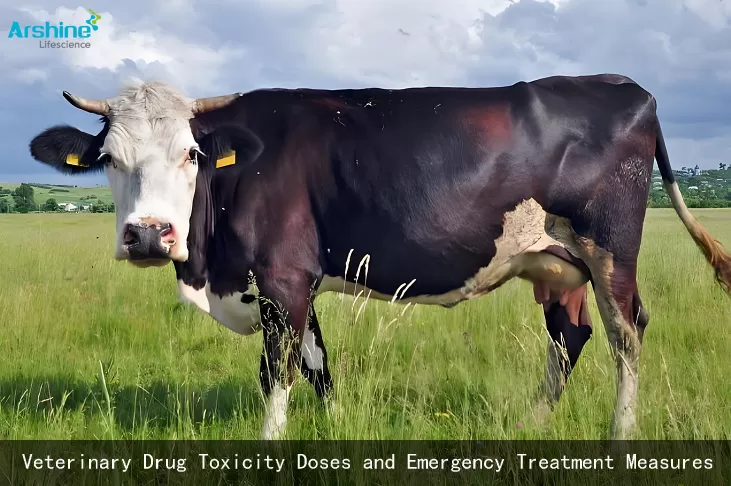
In veterinary practice, we often encounter cases of poultry drug poisoning due to farmers' lack of knowledge about veterinary drug usage and indiscriminate overdosing. Below are toxic doses and side effects of poultry drugs (including banned ones) for reference.

Olaquindox: Single dose >70 mg/kg body weight
Mequindox: >1 g/kg body weight
Halofuginone: Sensitive in geese, ducks, and guinea fowl; >9 ppm
Potassium permanganate: >1‰
Copper sulfate: >5/10,000
Maduramicin: >7 ppm
Furazolidone: Ducks are highly sensitive; >50 ppm
Streptomycin: >500 mg/kg body weight
Salt: >5‰ in feed
Trichlorfon (organophosphate): Oral dose >75 mg/kg (geese are more sensitive)
Dimetridazole: Waterfowl sensitive; >2/10,000
Sulfonamides: Chronic overdosing
Tetramisole: Geese are sensitive
Salinomycin: Toxic to turkeys
Monensin: Toxic to Japanese quail
Dinitolmide: Toxic to pigeons
Bromochloroketone: Impairs growth
Note: Some drug combinations increase toxicity.
Amantadine, streptomycin, chlortetracycline, chloramphenicol, furazolidone, sulfonamides, aminophylline, moroxydine, barbiturates, cholinergics, adrenaline, testosterone, compound norethisterone tablets, and certain vaccines.
Thiamphenicol, chloramphenicol, tetracyclines (chlortetracycline, oxytetracycline), streptomycin, kanamycin, neomycin, disinfectants, certain antiviral drugs, some traditional Chinese herbs, toxins, and contaminants.
Clinical Signs:
Acute toxicity in all ages (especially chicks) after prolonged use (>7 days)
Depression, weakness, anorexia, dyspnea, cyanotic comb/wattle, jaundice, anemia
Rash under wings, dark brown/white feces, egg drop (soft-shelled eggs), mortality
Necropsy Findings:
Hemorrhages in skin, muscles, and organs
Enlarged liver (purple/yellow-brown) with necrotic foci
Swollen kidneys (pale yellow), urate-filled ureters
Hemorrhagic GI mucosa, splenomegaly with necrosis
Prevention:
Avoid in chicks <1 month and laying hens
Strict dosing (≤5 days)
Use combination sulfonamides (e.g., sulfadoxine-trimethoprim) for lower toxicity
Choose poorly absorbed sulfonamides (e.g., sulfaguanidine) for gut infections
Ensure adequate water intake
Treatment:
Stop drug immediately
Provide 1–2% sodium bicarbonate water
Add to feed: Vitamin C (0.2g/kg) + Vitamin K3 (5mg/kg) until recovery
Clinical Signs:
Reduced appetite, egg drop
Diarrhea, leg weakness, pale combs, purple skin, ruffled feathers
Chicks: stunted growth, lethargy
Necropsy Findings:
Edema/hemorrhage in proventriculus/duodenum, ulcerated gizzard
Swollen, friable liver (yellow-brown), congested kidneys
Chalky deposits on heart/liver/lungs/air sacs
Prevention:
Dose: 25–50 mg/kg twice daily (≤7 days; allow 2–3-day intervals)
Treatment:
Discontinue drug
Offer mung bean broth, licorice water, or 5% glucose solution
Clinical Signs:
Chronic: Reduced intake, green diarrhea, emaciation, red/dry feet, leg paralysis
Acute: Anorexia, paralysis, mortality
Necropsy Findings:
Chronic: Muscle hemorrhages; dark red liver/kidneys; intestinal congestion
Acute: Swollen liver/kidneys (brown); intestinal hemorrhage
Prevention:
Strict dose: 5 ppm (5g/ton feed)
Never exceed 6.5 ppm
Mix feed thoroughly
Limit use: 7 days on, 3–5 days off for broilers; withdraw 1 week pre-slaughter
Treatment:
Stop medicated feed
Water supplementation: 3% glucose + 0.02% Vitamin C
Severe cases: Oral rehydration via tube (2× daily); recovery in ~5 days
Add: Block 14, No.100, Luyun Road, Changsha 410205, Hunan, China.
Email: info@arshinevet.com
WeChat: +8618874001228
WhatsApp: +8615697311407
Tel:86-731-82294958